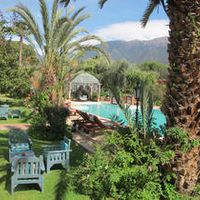The Atlas Mountains are a magnet for trekkers, mountain bikers, enthusiasts of Amazigh (Berber) culture and anyone in search of solitude. There are three ranges: the Middle Atlas, with its cedar forests and birdlife, the seldom-visited Anti-Atlas and the soaring heights of the High Atlas, culminating in 4,167-metre Jebel Toubkal.
Most visitors head for the High Atlas, whose foothills can be reached in a one-hour drive from Marrakech. In recent years visitor opportunities in the High Atlas have increased considerably. A five-star skiing resort is under construction at Oukaimeden. Trekking, paragliding and quad-biking are all on offer. Or you can hole up in a mountain retreat with a swimming pool and a hydro-jet massage.
As you drive up the winding roads, one of the first things you see are men standing by the road selling fossils and minerals. The Atlas is a showcase for the geology of the Jurassic and Cretaceous eras and you can buy stunning trilobites, ammonites and geodes for a few dozen dirhams (don’t forget to bargain!)
On a shorter timescale, this is the heart of Amazigh (Berber) countryside where the way of life has changed little in a thousand years. A network of paths and mule tracks lead through forests, hunting reserves and fields sown with barley, corn, maize, turnips and alfalfa or planted with olive, orange and lemon trees. Only 80 years ago these places had never been visited by Europeans, and they still possess an other-worldly quality. To the east, lies the Ait Bouguemez valley, home of the oldest-established tribe in the region. The valley is the starting point for hikes up to the massif of Jbel M’Goun, site of some of the most spectacular mountain scenery in Morocco.
The Middle Atlas has an altogether different atmosphere. Often called ‘the Switzerland of Morocco’ it is a placid, mid-altitude region dotted with lakes and forests of cedar, cork and holm-oak. In the 1930s, the French built the Alpine-style resort of Ifrane, complete with red-roofed chalets and ski runs.
The Anti Atlas stretches from the Atlantic Ocean at Sidi Ifni to the 3,304-metre high volcanic massif of Jebel Siroua. The mountains offer dramatic trekking through gorges, lush valleys and isolated villages. In the centre of the region is the village of Tafraoute, surrounded by red granite mountains and the famous ‘blue rocks’ of Belgian artist Jean Verame.
Ouirgane sits over 1000 metres above sea level in a very beautiful valley in the high Atlas mountains. Only 75 minutes drive from Marrakech, it is a great place to relax totally amongst kind Berber people, spectacular natural views and the pleasures of a 'simple life'.
The souk or market is on Thursday and people come from the surrounding villages and valleys to buy and sell goods. Walking and mule trekking are the most common daytime activities in the area and the hotels we work with can arrange mountain guides to accompany you for a half or full day. Ouirgane is a perfect combination with a few days in Taroudant, which is reached by crossing the spectacular Tiz n Test pass.

It was the combination of different experiences over 10 days which really delighted us.
Dear Max
Many thanks for your email. We arrived back in Manchester on Saturday evening having experienced a wonderful holiday in Morocco, thanks to the excellent organisation of Lawrence of Morocco in organising the itinerary and the incredibly warm welcome and fantastic service we received from everyone we met on our journeys.
We kept asking each other what was our …
Freelance travel writer, James Stewart, travelled to Oualidia with Lawrence of Morocco in November 2012, writing for the Independent and easyJet in-flight magazine.
We really know Morocco and have had the pleasure of making many people's dream trips become reality over the years. It has been our privilege to be asked to manage holidays, weddings and productions for so many fantastic and discerning clients. We remain small and dedicated to providing excellent honest advice to enable you to sit back, relax and enjoy the fun bits without having to manage the unpredictability of this fascinating country.
If you want it done right, look no further!